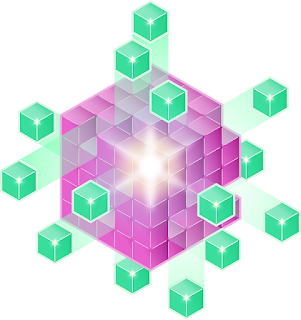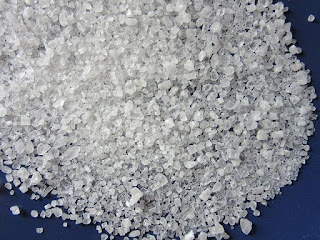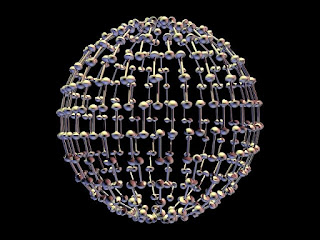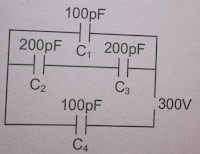Solid state previous year questions CBSE with answers( Two and Three Mark )
Solid state previous year questions CBSE with answers( Two and Three Mark )
These are Solid State previous year questions for CBSE .
Two Marks Question:
1.
An element having bcc structure has atomic mass 50u
and density 6.81 gcm-3 Calculate the edge length of the unit cell.
(NA=6.02 * 1023 mol-1) (AI 2001 C)
2.
Unit cell of an element (atomic mass 108u and
density 10.5g cm-3)has an edge length 409pm Deduce the type of
crystal lattice . (NA=6.02 * 1023 mol-1)
3.
Nacl crystals are doped with 2*10-3
mol percent of SrCl2 , calculate the cation vacancies per mole. (NA
=6.02 * 1023 mol-1)
(Delhi 2001C)
4.
Lithium metal crystal has body centred cubic structures density is 0 53 g cm-3 and its atomic mass is 6.94 g mol -1 .Calculate
the volume of a unit cell of lithium
metal . (NA =6.02 * 1023
mol-1) (Al 2001)
5.
Sodium crystallizes in the cubic lattice
and the edge of the unit cell is 430 pm .Calculate the number of atoms in the
unit cell (Atomic mass of Na = 23.0u, density of sodium =0.963g cm-3) ) (NA =6.02 * 1023 mol-1) (Al
2001)
6.
An element crystallizes in fcc structure .200 g of this element has 4.12*1024
atoms. The density of A is 7.2 g cm-3
. Calculate the edge length of the unit cell. (AI. 2001)
7.
State the difference between Schottky and
Frenkel defects. Which of the two
changes the density of the solid? (A1 2002)
8.
The density of chromium metal is 7.2 g cm-3.
If the unit cell has edge length of 289pm , determine the type of unit cell .(atomic mass of Cr =52
u, NA =6.02 * 1023
mol-1) (Al 2003 C)
9.
An element occurs in bcc structure with cell edge 300pm. The density of
the element is 5.2 g cm-3. How many atoms of the element does 200 g
of the element contain? (Delhi 2003 C)
10.
Explain the following with suitable examples
An n type semiconductor (Delhi
2006 C)
11.
Copper crystallizes into an fcc lattice with
edge length of3.61*10 -8cm . Calculate the density of copper (Given
Cu =63.5g mol-1 , NA =6.02 * 1023 mol-1 ) (Delhi
2009 C)
12.
A. In reference to crystal structure explain the
meaning of coordination number?
(Delhi 2009 C)
B.What is the number of atoms in
a unit cell of
a.) face centred cubic structure
b.) body centred cubic
structure
(Delhi
2009 C)
13.
How is crystals affected by Schkotty and Frenkel
defects? (Delhi 2009 C)
14.
The well known mineral Fluorite is chemically
calcium chloride .It is known that in one unit cell of this mineral there are 4
Ca2+ ions and 8 F- ions and that Ca2+are arranged
in a fcc lattice .The F - ions fill all the Tetrahedral holes in the
face centred cubic lattice of Ca2+ ions .The edge of the unit cell
is 5.46 *10-8 cm in length. The density of the solids is 3 .18 g cm-3.
Use the information to calculate Avogadro's number (Molar mass of CaF2,
78.08 g mol-1) (Delhi 2010)
15.
In terms of band theory explain the difference
between a conductor and a semiconductor and give one example of each (AI.2011
C)
16.
Explain the following terms with suitable
example of each
i.)Ferromagnetism ii.)Antiferromagnetism (Delhi 2011 C)
17.
Calculate the packing efficiency of a metal
crystal for a simple cubic lattice (AI.2011)
18.
Calculate the number of unit cells in 8.1g of
aluminium if it crystallizes in a face-centred structure. (Atomic mass of Al = 27 g mol-1) (2017)
Three Marks Questions:
1.
Determine the type of cubic lattices to which
the iron crystal belongs if it has edge length of 290 pm and the density is 7.87
g cm-3 (At mass of Fe =56 g mol-1, , NA =6.02 * 1023 mol-1 ) (Delhi
2005)
2.
Aluminium crystals in a cubic close-packed
structure is metallic radius is 125 pm .
a.)
What is the length of the edge of the unit cell?
b.)
How many such unit cells are there in a 100 cm3
of aluminium (Delhi 2005)
3.
What is a semiconductor? Describe two main types
of semiconductors, giving examples and their distinctive features . (AI.2006 )
4.
Assign reasons for the following
i.)Phosphorus doped silicon is a semiconductor
ii.)Schottky defect lower the density of a solid
iii.) Some of the very old glass objects appear slightly milky instead of being transparent
i.)Phosphorus doped silicon is a semiconductor
ii.)Schottky defect lower the density of a solid
iii.) Some of the very old glass objects appear slightly milky instead of being transparent
5.
Silver crystallises in an fcc lattice. The edge
length of its unit cell is 4. 077 10-8 cm and is 10.5 g cm-1.
Calculate on this basis the atomic mass of silver (N=6.023x1023 mol-1
) (A.1.2008)
6.
What is semiconductor? Describe two main types
of semiconductors and explain mechanism of their conduction.
(Delhi 2008)
7.
Explain the following giving a suitable example
in each case:
i.) Paramagnetism
ii.)Frenkel defect
iii.) Ferrimagnetism (Foreign 2008)
i.) Paramagnetism
ii.)Frenkel defect
iii.) Ferrimagnetism (Foreign 2008)
8.
How would you account for the following?
i.) Frenkel defects are not found in ionic solids of nearly equal sizes of cations and anions ii.)Impurity doped silicon is a semiconductor (Foreign 2008)
i.) Frenkel defects are not found in ionic solids of nearly equal sizes of cations and anions ii.)Impurity doped silicon is a semiconductor (Foreign 2008)
9.
Silver crystallizes with face-centred cubic
until cells. Each side of the unit cell has a length of 409 pm. What is the
radius of an atom of silver? (Assume that each face atom is touching corner
atoms)
(AI.2009)
10.
Iron has a body centred cubic unit cell with a
cell edge of 286.65 pm. The density of iron is7.87 g cm-1 . Use this
information to calculate Avogadro's number (At mass of Fe = 56 g mol-1 )(Delhi
2009)
11.
The density of lead is 11.35g cm-3 and
the metal crystallizes with fcc unit cell. Estimate t
radius of lead atom .
(Delhi
2011)
12.
Calculate the distance between Na+ and
Cl- ions in NaCl crystal if its density is 2. 165 g cm-3[Molar
mass of Nacl = 58.5 g mole-1 ,NA =6.02*1023 mol-1
] (2006)
13.
The density of Copper metal is 8.95 g cm-1
.If the radius of copper atom be 127.8 pm , is the copper unit cell simple
cubic, body-centred or face centred cubic?(Given Atomic mass of Cu =63. 54 g mol-1 , NA =6.02*1023
mol-1) (2010)
14.
An element with molar mass 27 g mol-1 forms a cubic unit cell with edge
length 4.05*10-8 cm its density is 2.7g cm-3, what is the
nature of the cubic unit cell?
(Delhi 2015)
(Delhi 2015)
15.
An element crystallizes in a fcc lattice with
cell edge of 400 pm. The density of the element is 7 g cm-3 . How
many atoms are present in 280g of the element?
(AI. 2016)
16.
An element crystallizes in a f.c.c lattice with
cell edge of 250 pm. Calculate the density of 300 g of this element containing 2*1024 atoms. (Delhi 2016)
17.
a.)Based on the nature of intermolecular forces
classify the following solids:
Silicon carbide.Argon
(b) ZnO turns yellow on heating. Why?
(c) What is meant by groups 12-16 compounds? Give an example . (2017)
Silicon carbide.Argon
(b) ZnO turns yellow on heating. Why?
(c) What is meant by groups 12-16 compounds? Give an example . (2017)
HINTS & SOLUTIONS
SOLID STATE
N= 2x 200
(300)3 x 10-10 x 5.2 cm 3
= 4 x 63.5
(3.61 x 10-8 )3 x 6.022 x 1023






17.Let the edge length is a, radius of atom = r ,V of cube = a3
AB = r+r
A=2r
Volume of cube = (2r)3 = 8r3
No of atom in simple cube = 1
Volume of one atom = 4/3 πr3
Two Marks Questions:
1.
Z =2, M=50 gm mol-1 , d=6.81g cm -3
a3 = ZxM
d x NA
a3 =2x 50
6.18 x6.02x1023
a=289.6 cm
a3 = ZxM
d x NA
a3 =2x 50
6.18 x6.02x1023
a=289.6 cm
2.
Z=?, M=108 u, d=10.5 g cm, a = 409 pm, NA=
6.02x1023 mol-1
d =ZxM
a3 x NA
Z= d xa3 x NA
d =ZxM
a3 x NA
Z= d xa3 x NA
M
Z= 10.5gcm-3 x(409)3
x 10-30 cm x 6.02x1023 Cm
108
Z=4, FCC structure
3.
Cation vacancies = Number of Sr2+
ions ,add =2x10-5 mol = 2x10-5 x 6.023x1023 =
1.2046x1019 mol
4.
Z=2, d= ZxM
a3 x NA
a3 = ZxM = 2x 6.94
d x NA 0.53x 6.23 x1023
= 4.348x 10-23 cm
a3 x NA
a3 = ZxM = 2x 6.94
d x NA 0.53x 6.23 x1023
= 4.348x 10-23 cm
5.
Z=d x NA x a3
M
=0.9623 cm3 x6.023x1023 x (430)3 x (10-10 )3cm 3
23
Z=2
6. Z=4, M=200 g, N=4.12x1027, d=7.2 g cm3
a3= Z x M
d x N
a3= 4 x 200
=0.9623 cm3 x6.023x1023 x (430)3 x (10-10 )3cm 3
23
Z=2
6. Z=4, M=200 g, N=4.12x1027, d=7.2 g cm3
a3= Z x M
d x N
a3= 4 x 200
7.2x4.12x1027
a=299.8 pm
7.
Schottky defect arises due equal number of
cation and anion missing - density decreases Frenkel defect arises due to equal no of cation & anion
leaves its normal site and occupies interstitial site - density remains
constant
8.
Z=d x a3 x NA = 7.2
g cm-3x (289)3 x 10-30 cm3 x 6.02 x
1023
M
52
Z =2 (body centre)
9.
Z=2
N=2 x M
a3 x d
N= 2x 200
(300)3 x 10-10 x 5.2 cm 3
N=
400
27 x 10 27 x5.2
27 x 10 27 x5.2
=2.85x1024 atoms
10.
When the Group - 14 element doped with upon -15,
element n-type semiconductor is able
e.g. silicon doped with phosphorous
11.
d= Z x M
a3 x NA
= 4 x 63.5
(3.61 x 10-8 )3 x 6.022 x 1023
= 8.965 g cm-3
12.
a) Coordination no: the no of atom surrounded by
nearest neighbour
b) (i) Four (ii) Two
14.The No of
molecule per unit cell is 4
N = ZxM
a3 xd
N = ZxM
a3 xd
Z=4. M=78.08 g mol-1 ,a=5.46x10-8,
d=3.18 g cm -3
NA =4x78.08
(5.46x 10-8)3 X3.18
NA =4x78.08
(5.46x 10-8)3 X3.18
=6.03x1023cm
15.Conductor According to band theory the energy gap is very
small in conductor Semiconductor: According to band theory the energy gap is
more than conductor but less than insulator
17.Let the edge length is a, radius of atom = r ,V of cube = a3
AB = r+r
A=2r
Volume of cube = (2r)3 = 8r3
No of atom in simple cube = 1
Volume of one atom = 4/3 πr3
Packing fraction = 4/3 πr3 x100 = 52.4%
8r3
18. Moles of aluminium = Mass/ molecular
mass
We know that one unit f.c.c., No. of atoms
= 4 nAl =8.1/2.7 =0.3moles
4 - atoms are found in unit cell = 1
4 - atoms are found in unit cell = 1
1- atoms are found in unit cell =1/4
(1 mole) NA atoms are found in unit cell = NA/4
(1 mole) NA atoms are found in unit cell = NA/4
0.3 moles atoms are found in unit cell = NA/4x0.3=
0.075xNA
Three Marks Questions:
1.
d= ZxM
a3 x NA
a3 x NA
7.87=Z x 56
(290 x 10-10)3 x 6.02 x 102
(290 x 10-10)3 x 6.02 x 102
Z=2 bcc structure
2.
a.) In cubic close packing structure
4r=√2a
r = 125x10-12 m
a=4r/√2 = r2√2 = 125x 10-12 x 2√2 = 354pm
4r=√2a
r = 125x10-12 m
a=4r/√2 = r2√2 = 125x 10-12 x 2√2 = 354pm
b) a3 = (354x10-12 m)3
a= 44.21x10-30 m3
No. of unit cell in 1 cm3 = total value/V. of one unit cell = 10-6 m3 2.261x1023 unit cell
44.21 x 10-30 m3
a= 44.21x10-30 m3
No. of unit cell in 1 cm3 = total value/V. of one unit cell = 10-6 m3 2.261x1023 unit cell
44.21 x 10-30 m3
3.
The solids with intermediate conductivities
between insulators and conductors are termed semiconductors
(i) n-type semiconductor : It is obtained by doping Si or Ge with a group 15 element like P. Out of 5 valence electrons only 4 are involved in bond formation and the fifth electron is delocalized and can be easily provided to the conduction band. The conduction is thus mainly caused by the movement of electron.
(i) n-type semiconductor : It is obtained by doping Si or Ge with a group 15 element like P. Out of 5 valence electrons only 4 are involved in bond formation and the fifth electron is delocalized and can be easily provided to the conduction band. The conduction is thus mainly caused by the movement of electron.
(ii) p-type semiconductor: It is obtained
by doping Si or Ge with a group 13 element like Gallium which contains only 3
valence electrons. Due to missing of 4th valence electron, electron hole or
electron vacancy is created. The movement of these positively charged hole is responsible for the
conduction
4.
i.)Because after doping the phosphorus as the
conductance is intermediate between conductor & Insulator
ii) Because in Schottky defect equal no of
cation & anion is missing
iii) Because in day ,glass is heating but in night, glass is cooling e.g. annealing after some year glass acquired crystalline structure.
iii) Because in day ,glass is heating but in night, glass is cooling e.g. annealing after some year glass acquired crystalline structure.
5.
M = d xa3 x NA
Z
=10.5 g cm3 x(4.077 x 10-8 )3x6.023 x 1023
Z
=10.5 g cm3 x(4.077 x 10-8 )3x6.023 x 1023
4
=107.143
=107.143
6.
See solution of question No. 3 (Three Marks)
7.
(i) Paramagnetism : Materials which are weakly
attracted by magnetic fields are called paramagnetic materials and the property
that exhibited is called paramagnetism. Paramagnetic substances contain
unpaired electrons, e.g. TiO,CuO,O2 and VO2 etc.
(ii) Piezoelectric effect: When the electricity is produced by applying mechanical stress polar crystals, is known as piezoelectric effect. Quartz show this property
(ii) Piezoelectric effect: When the electricity is produced by applying mechanical stress polar crystals, is known as piezoelectric effect. Quartz show this property
(iii) Frenkel defect in crystals: Frenkel
defect occurs when an atom or ion (generally cation) leaves the normal site in
the crystal -lattice (creating a vacancy) and occupies on interstitial site.
This defect is generally found is silver halides because of the small size of
Ag+ ions.
8.
i.)Because in Frenkel defect size of cation
should be smaller than the size of anion so cation goes to void.
(ii) When silicon doped with impurities
like boron positive hole is formed when is doped with arsenic free electron
present.
9.
145.03 pm
In fcc d = a/√2
In fcc d = a/√2
r=a/2√2
= 409/ 2√2 =144.6 pm
10.
NA
= ZxM
1 a3 x NA
1 a3 x NA
NA = 2x56g mol-1
(286.65x 10-10)3 x7.87
NA = 6 x 10-23
(286.65x 10-10)3 x7.87
NA = 6 x 10-23
11.
1.7494,10-8 cm.
a3= ZxM
d x NA
a3= ZxM
d x NA
a3
= 4x207
6.02 x1023 x11.35
6.02 x1023 x11.35
r=a/2√2
, r = 4.948x10-8 cm a =
4.948 x 10-8cm
2 x 1.4142
2 x 1.4142
12.
d= ZxM
a3 x NA
a3 x NA
a=281 pm
13.
4 (fcc)
14.
Molar
mass of the given element, 27 g mol-1 = 0.027 kg mol-1
Edge length, =4.05x 10-8 cm = 4.05x10-10 m
Density, =2.7 g cm-3 = 2.7x103
Applying the relation
d= ZxM
a3 x NA
Edge length, =4.05x 10-8 cm = 4.05x10-10 m
Density, =2.7 g cm-3 = 2.7x103
Applying the relation
d= ZxM
a3 x NA
Where, Z is number of atoms in the unit cell and NA is the
Avogadro number
Z=d xa3 xNA
M
= 2.7x103 (4.05 x 10-10)3 x6.022x1023/ 0.027 = 4
Since the number of atoms in the unit cell is four, the given cubic unit cell has face-centred cubic (fcc) or cubic-close packed (ccp) structure.
Z=d xa3 xNA
M
= 2.7x103 (4.05 x 10-10)3 x6.022x1023/ 0.027 = 4
Since the number of atoms in the unit cell is four, the given cubic unit cell has face-centred cubic (fcc) or cubic-close packed (ccp) structure.
15.
Volume of unit cell = a3 [ a= edge
length ] = 400 pm
= (400 x 10-12m)3 =(400
x 10-10cm)3 = 64*10-24
cm3
Volume of 208 g of the Element = mass/ density
=208g/7g cm -3 = 29.71 cm3
No. of unit cells in this volume = volume of 208 g of element
volume of one unit cell
=29.71/64 x 10 -24 = 0.46 x 1024
=208g/7g cm -3 = 29.71 cm3
No. of unit cells in this volume = volume of 208 g of element
volume of one unit cell
=29.71/64 x 10 -24 = 0.46 x 1024
Since each fcc unit cell contains 4 atoms
therefore ,total no of atoms in 208 g
=4 x 0.46 x1024
=1.84 x 1024 atoms
=4 x 0.46 x1024
=1.84 x 1024 atoms
16.
Molecular mass of element = 300 x 6 x 1023 = 90 amu
2x1024
Density = Z M
N0xa3
=4x90
6 x 1023 x ( 250 x 10-10)3
=4x90
g/cc
6x 2.5x 2.5 x 2.5 x 10-1
17.
On the basis
of intermolecular forces: - (i) Silicon carbide : - Covalent network solid
(Covalent Bonding)
(ii) Argon : - Non-polar molecular solid which posses dispersion or london forces.
(ii) Argon : - Non-polar molecular solid which posses dispersion or london forces.
(b) Žinc oxide is white in colour at room
temperature. On heating it loses oxygen & turns yellow
Zno - Zn2+ + ½ O2 +
2e-
the excess Zn2+ ions move to interstitial sites and the electron to neighbouring interstitial sites
the excess Zn2+ ions move to interstitial sites and the electron to neighbouring interstitial sites
(c) Some of the compound like Zns, CdSe and
HgTe are example of group 12 - 16 compound.In these compound bonds are having
same ionic character along with covalent.
Check out : Electrostatics Five mark questions with answers for CBSE Class 12 (previous year )
Check out : Electrostatics Five mark questions with answers for CBSE Class 12 (previous year )
Please Share and Help Others











Comments
Post a Comment
Feel free to ask if you have any queries and if want any information . I feel happy to interact with you all and help you .